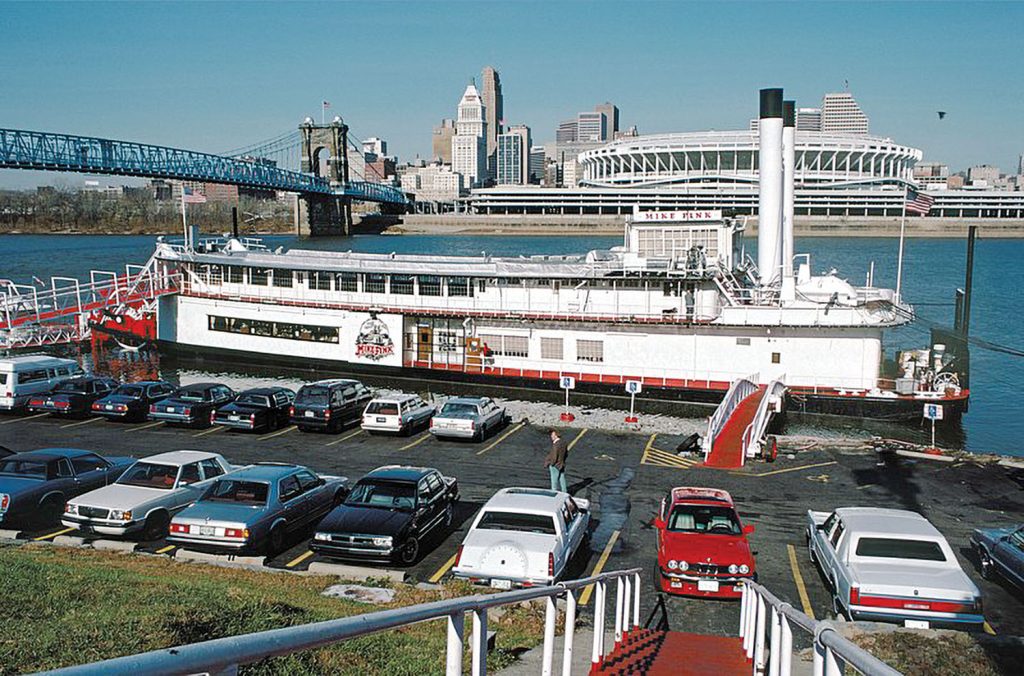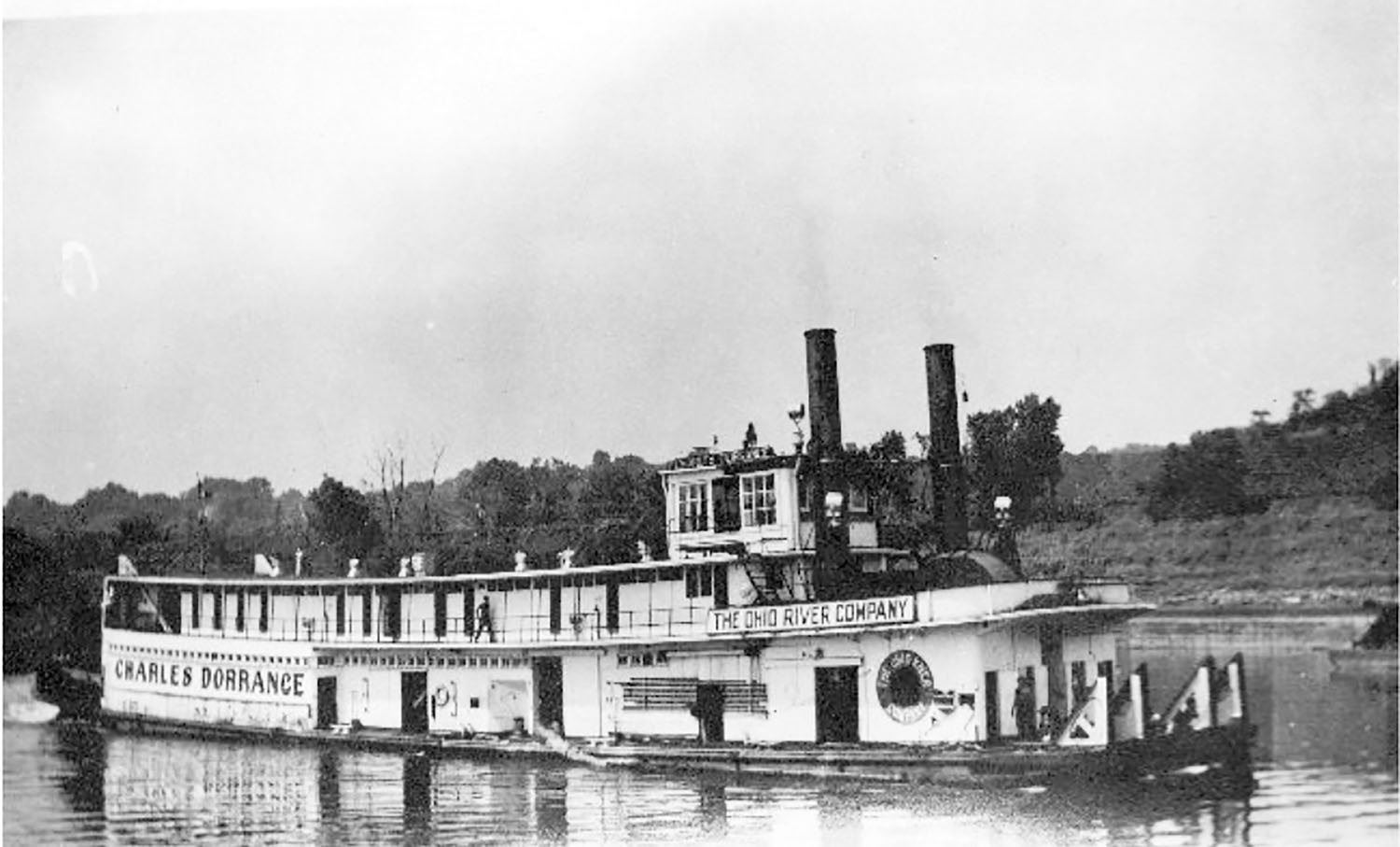The last column looked at the John W. Hubbard (Way’s T1444), a steam sternwheel towboat built by Dravo in 1936 for Campbell Transportation of Pittsburgh. It was the second of three nearly identical vessels that Dravo would build that year, and they would be the last steam sternwheel boats built by that yard. The Hubbard had a steel hull measuring 171.5 by 34 feet, and the condensing engines were 16’s, 32’s, 8-foot stroke rated 1,000 hp., built by the Marietta Manufacturing Company of Point Pleasant, W.Va. The new boat entered service in July 1936 under the command of Capt. Vernon Byrnside, and it was joined a short time later by the Charles T. Campbell (T0390).
These two boats were usually in a run from Pittsburgh to Memphis for the Campbell Line, but they would also be seen on the Upper Mississippi as far up as St. Louis and Wood River. In 1941, the Campbell Line was merged into the Mississippi Valley Barge Line Company (Valley Line), and the two big sternwheelers continued to work under their original names. In 1947, the Valley Line sold the two boats to The Ohio River Company (Orco) of Cincinnati.
Orco was formed as a transportation subsidiary of the West Virginia Coal & Coke Company in the mid-1920s. In 1936, Orco had taken delivery of the Omar from Dravo, which was the first of the three similar boats that included the Hubbard and Charles T. Campbell. The Omar had performed well for Orco, and it had delivered some record coal tows from Huntington, W.Va., to Cincinnati. It is little wonder that Orco would be interested in the two sister vessels as well.
The Charles T. Campbell was soon renamed John J. Rowe (T1415) following the sale, but the John W. Hubbard continued to carry that name until 1950, when it was renamed Charles Dorrance (T0379). According to some material supplied by Capt. William F. “Bill” Judd of Cincinnati—whose memories of decking on the Dorrance inspired this column—Charles Dorrance was one of the founders of The Ohio River Company, and he once served as CEO and president of the West Virginia Coal & Coke Company. He had entered the coal industry at age 16, working in the family coal mines at Dorranceton, Pa. Judd says that he was also on the board of Cincinnati Gas & Electric, and he was known to visit aboard the boat that had been named in his honor. He passed away in 1977 at age 94.
This writer has known several rivermen who worked aboard the Charles Dorrance for Orco. One was Capt. Dan Smith, a pilot for Merdie Boggs & Sons at Catlettsburg when I was a kid hanging around there in the early 1970s, and probably the first to let me actually handle a boat. Another was Capt. Frank “Butter” Woodall, who spent his career with Orco, and the man whom I consider gave me my “driver’s test” and proclaimed me fit to be a pilot. These men spoke of their time aboard not necessarily in romantic terms as missing the “steamboat” days, but they detailed the hard work it actually was to be a steamboat deckhand. Orco even sent these big sternwheelers up the Kanawha River at times, and they were certainly not in easy trades.
Orco had been steadily modernizing its fleet with diesel vessels, and, in 1957, the Dorrance was the first of the three similar steam sternwheel boats to be retired. It was initially sold to Capt. Robert H. Bosworth’s Point Towing Company of Point Pleasant, W.Va., and it was utilized for a time as a landing boat at Kanauga, Ohio. It was later offered for sale in photo ads featured in The Waterways Journal. It was sold to interests in Cincinnati and ultimately to Capt. John Beatty. Beatty had made a popular floating restaurant out of the former Armco towboat Charles R. Hook (WJ February 13, 2023) named “Captain Hook’s,” and he rebuilt the Dorrance into an even larger restaurant to replace the Hook. This restaurant was named “Mike Fink” and opened in 1968 on the Cincinnati riverfront. After a long battle with the city over the mooring spot, the boat was moved across the river to Covington, Ky., and it became a fixture there for years.

In 1977, the floating restaurant was sold to the Bernstein family, and it became an immensely popular venue. For several Cincinnati Tall Stacks events the pilothouse of the vessel was utilized for those working in the event “Traffic Control,” monitoring the movements of the excursion vessels and coordinating commercial traffic through the bridges area. As one who worked in this capacity, it was somewhat surreal to sit there and envision what it might have been like for Capt. Vernon Byrnside to gaze out that front window when the boat was new.
In 2008, the Mike Fink closed so that the boat could go to drydock for extensive hull replacement and a complete renovation. Unfortunately, by the time the very costly hull work was completed, economic conditions did not make it feasible to restore the restaurant to operation at Covington. After several years it was sold to Bellaire Harbor Service, Bellaire, Ohio. According to a story in the February 8, 2019, issue of the WJ by H. Nelson Spencer, Bellaire owner Capt. Bob Harrison intended to utilize the former steamer as a landing boat and shop barge, a purpose it continues in today.
Caption for top photo: Str. Charles Dorrance of The Ohio River Company. (Dan Owen Boat Photo Museum collection)
Capt. David Smith can be contacted at davidsmith1955obc@gmail.com.



